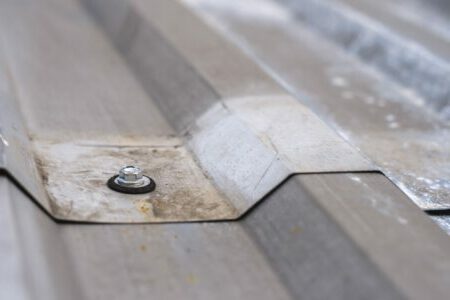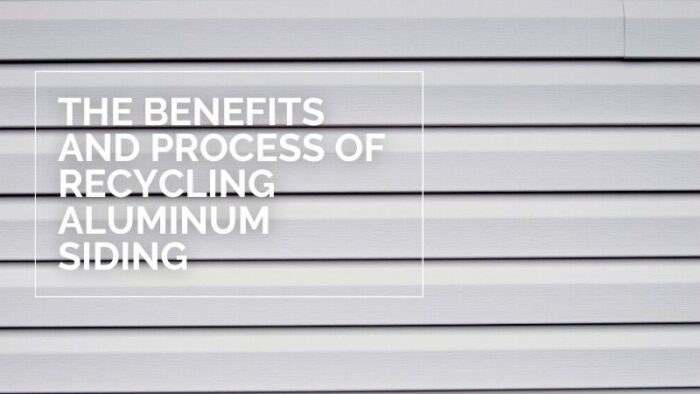Aluminum siding can be recycled. It is a type of metal, and metal is a recyclable material. Aluminum is one of the most widely recycled materials because it can be melted down and reused repeatedly without losing its properties.
If you want to recycle aluminum siding, you can check with your local recycling center to see if they accept it. Some centers may have specific guidelines for the type and condition of aluminum siding they will accept, so it’s a good idea to call ahead and ask.
Where to Recycle Aluminum Siding
There are several options for recycling aluminum siding. One option is to bring it to a local recycling center that accepts metal. You can check with your city or county’s waste management department to find the nearest recycling center. Many centers have specific guidelines for the type and condition of materials they will accept, so it’s a good idea to call ahead and ask if they accept aluminum siding.
Another option is to check with local scrap metal dealers or salvage yards. These businesses often pay for scrap metal, including aluminum siding, and may be able to take it off your hands.
You can also check with local contractors or remodeling companies. They may be interested in using your aluminum siding for their projects or know someone who can use it.
You can also check with charitable organizations or schools in your area. They may be interested in using the aluminum siding for a fundraising project or building material for a new construction project.

The Process of Recycling Aluminum Siding
The process for recycling aluminum siding typically involves the following steps:
- Collection: Aluminum siding is collected from homes, businesses, and other sources. This can be done through recycling programs, scrap metal dealers, or salvage yards.
- Transportation: The aluminum siding is transported to a recycling facility, where it is sorted and processed.
- Sorting: The aluminum siding is sorted by type and grade at the recycling facility. This is done to ensure that it is recycled most efficiently and effectively as possible.
- Shredding: The aluminum siding is then shredded into small pieces to make it easier to handle and process.
- Melting: The shredded aluminum siding is melted down in a large furnace. This process removes any impurities and contaminants, leaving a pure form of aluminum.
- Casting: The molten aluminum is poured into molds to create ingots or other shapes. These shapes are then cooled and solidified.
- Shipping: The recycled aluminum is then shipped to manufacturers, where it can be used to create new products.
Overall, recycling aluminum siding is efficient and cost-effective, making it a sustainable and environmentally-friendly option for disposing of this material.
Reusing Aluminum Siding
Reusing aluminum siding is a great way to reduce waste and save money. Here are a few ideas for reusing aluminum siding:
- Use it as a backdrop for a stage or event. Aluminum siding can be cut and shaped to create a unique and visually exciting backdrop for a stage or event.
- Use it as a siding material for a new construction project. If you are building a new structure, you can use aluminum as a cost-effective and durable siding material.
- Use it as a decorative element. Aluminum siding can be cut into shapes or used as a paneling material for walls or ceilings to add a unique and industrial aesthetic to a space.
- Use it as a tool for creating sculptures or other artistic projects. The flexibility and malleability of aluminum siding make it a valuable material for creating sculptures or other creative projects.
- Use it as a protective covering for outdoor equipment. Aluminum siding can be cut and shaped to fit over outdoor gear, such as air conditioning units or sheds, to protect them from the elements.
- Use it as a material for repairing or reinforcing other structures. Aluminum siding can be cut and shaped to fit over damaged areas of a structure to repair or strengthen it.
- Use it as a material for creating custom metalwork projects. The versatility of aluminum siding makes it helpful in creating custom metalwork projects, such as gates, railings, or fences.
Can You Throw Away Aluminum Siding?
You can throw away aluminum siding, but recycling it is generally more environmentally friendly. Recycling aluminum siding conserves natural resources, reduces energy consumption, and reduces greenhouse gas emissions. It also helps to reduce the amount of waste that ends up in landfills.
If you decide to throw away your aluminum siding, you should check with your local waste management department to see what options are available. Some areas have specialized recycling programs for metal, including aluminum siding, while others may require you to dispose of it as general trash.
If you cannot recycle your aluminum siding, it is essential to dispose of it properly to minimize any adverse environmental impacts. This may involve breaking it down into smaller pieces or removing any hazardous materials, such as nails or screws, before disposing of it.
Overall, it is generally more sustainable to recycle aluminum siding whenever possible. This helps to conserve natural resources, reduce energy consumption, and reduce waste.
Conclusion
Aluminum siding is a recyclable material that can be melted down and reused repeatedly without losing its properties. Recycling aluminum siding has numerous benefits, including conserving natural resources, reducing energy consumption, and mitigating greenhouse gas emissions.
There are several options for recycling aluminum siding, including local recycling centers, scrap metal dealers, and salvage yards. Reusing aluminum siding is also a great way to reduce waste and save money.
Recycling aluminum siding involves collecting, transporting, sorting, shredding, melting, casting, and shipping. Overall, recycling aluminum siding is an important and effective way to reduce waste and protect the environment.

